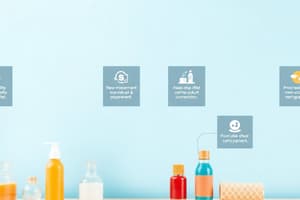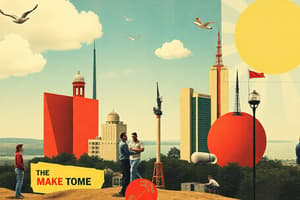Podcast
Questions and Answers
What is the primary determinant of a society's standard of living?
What is the primary determinant of a society's standard of living?
- The number of manufacturing companies present
- The level of managerial skills in the workforce
- The quality of raw materials in use
- The goods and services available to its people (correct)
Which type of goods are classified as consumer goods?
Which type of goods are classified as consumer goods?
- Goods that require extensive repairs
- Goods that are purchased directly by the consumer (correct)
- Goods that are in short supply
- Goods used to manufacture other products
What characterizes the rapid growth phase of the product life cycle?
What characterizes the rapid growth phase of the product life cycle?
- Sales revenue decreases significantly
- The product is still in developmental stages
- The product is replaced by newer models
- Products become standardized and volume increases rapidly (correct)
Which of the following is NOT a typical characteristic of the maturation stage of a product life cycle?
Which of the following is NOT a typical characteristic of the maturation stage of a product life cycle?
Which factor is considered the largest part of manufacturing costs?
Which factor is considered the largest part of manufacturing costs?
What is a key feature of sustaining technology in product development?
What is a key feature of sustaining technology in product development?
During which phase of the product life cycle does a product start to be replaced by improved products?
During which phase of the product life cycle does a product start to be replaced by improved products?
What is a characteristic of a flow shop?
What is a characteristic of a flow shop?
What inventory control method is used in linked-cell shops?
What inventory control method is used in linked-cell shops?
Which of the following is NOT an interactive factor in manufacturing?
Which of the following is NOT an interactive factor in manufacturing?
Which type of shop is characterized by the immobility of the item being manufactured?
Which type of shop is characterized by the immobility of the item being manufactured?
What is a primary use of continuous process manufacturing?
What is a primary use of continuous process manufacturing?
What is a potential downside of the flow shop system?
What is a potential downside of the flow shop system?
What are the interrelated factors in manufacturing that must be combined properly?
What are the interrelated factors in manufacturing that must be combined properly?
A change in design has what kind of impact on the manufacturing process?
A change in design has what kind of impact on the manufacturing process?
What is the primary goal of a successful manufacturing system?
What is the primary goal of a successful manufacturing system?
What does a production system encompass?
What does a production system encompass?
What is the ultimate purpose of the manufacturing system?
What is the ultimate purpose of the manufacturing system?
Which statement correctly describes Service Production Systems (SPSs)?
Which statement correctly describes Service Production Systems (SPSs)?
To achieve efficient manufacturing, what is crucial for the knowledge of materials?
To achieve efficient manufacturing, what is crucial for the knowledge of materials?
What is the significance of quality in the context of production systems?
What is the significance of quality in the context of production systems?
Which item is not considered a part of the production system?
Which item is not considered a part of the production system?
What is the primary objective of manufacturing?
What is the primary objective of manufacturing?
Which of the following is not one of the basic machining processes?
Which of the following is not one of the basic machining processes?
What role does a design engineer typically not handle?
What role does a design engineer typically not handle?
Which manufacturing system is characterized by a large variety of components and a functional layout?
Which manufacturing system is characterized by a large variety of components and a functional layout?
Which of the following is a type of machine tool?
Which of the following is a type of machine tool?
Which of these processes converts unfinished materials to finished products?
Which of these processes converts unfinished materials to finished products?
Which of these statements incorrectly describes milling?
Which of these statements incorrectly describes milling?
Which of the following processes does not involve metalworking?
Which of the following processes does not involve metalworking?
What is the role of a manufacturing engineer?
What is the role of a manufacturing engineer?
Which characteristic of process technology refers to the capability to perform tasks under various conditions?
Which characteristic of process technology refers to the capability to perform tasks under various conditions?
In the Toyota Production System, which aspect is primarily emphasized to ensure quality?
In the Toyota Production System, which aspect is primarily emphasized to ensure quality?
What is a primary goal of World Class Manufacturing (WCM) in terms of production processes?
What is a primary goal of World Class Manufacturing (WCM) in terms of production processes?
Which process characteristic involves the analysis of costs and economic factors?
Which process characteristic involves the analysis of costs and economic factors?
What is the significance of measuring lead time in World Class Manufacturing?
What is the significance of measuring lead time in World Class Manufacturing?
Flashcards are hidden until you start studying
Study Notes
Standard of Living and Materials
- Standard of living reflects the availability of goods and services to a society’s people.
- Manufactured goods split into two categories:
- Producer goods (intermediate goods for production).
- Consumer goods (purchased directly by consumers).
Product Development
- Sustaining technology enhances innovations, offering greater consumer value through improved materials and design.
- Product development typically follows an “S” curve trajectory.
Product Life Cycle Stages
- Start-up: Introduction of new product/company with low volume.
- Rapid Growth: Standardization occurs, and production volume increases swiftly; capacity often strained.
- Maturation: Emergence of standard designs; significant for process development.
- Commodity: Standard long-life products; Decline phase sees replacement by enhanced alternatives.
Interactive Manufacturing Factors
- Key factors in manufacturing include product design, materials, labor costs, equipment, and overall manufacturing costs.
- Manufacturing costs typically encompass about 40% of the final selling price, with material costs making up around 50% of manufacturing expenses.
Materials and Process Integration
- Selecting materials aligned with design requirements is crucial for effective production and quality control.
- The interplay among materials, processes, and design is vital to maintaining low costs and quality.
Manufacturing and Production Systems
- Manufacturing meets societal demands by converting inputs into goods and services.
- Production systems encompass all company resources, including people, management, equipment, and markets.
Basic Manufacturing Processes
- Core processes include casting, metalworking, machining, assembly, surface treatments, rapid prototyping, and heat treating.
Major Manufacturing Techniques
- Basic machining processes: shaping, drilling, turning, milling, sawing, broaching, and abrasive machining.
- Types of machine tools include shapers, drill presses, lathes, and grinders.
Manufacturing Operation Dynamics
- Jobs entail related operations performed at specific stations.
- Categories of operations encompass handling, processing, packaging, inspecting, and storing.
Products from Manufacturing
- Manufacturing leads to products via fabricating (from pieces) or processing (continuous operations).
- Workpieces aim for specific geometry, size, and finish.
Engineering Roles in Manufacturing
- Design engineers focus on functionality, assumptions, service environments, and final appearance.
- Manufacturing engineers select processes and equipment; industrial engineers handle layout, while materials engineers specify and develop materials.
Evolving Manufacturing Landscape
- Global competition, advanced technologies, and innovative manufacturing system strategies have transformed the industry.
Manufacturing System Designs
- Job shops focus on variety, flow shops on volume, linked-cell shops on lean production, and project shops on immobile items.
- Continuous processes manufacture fluids and powders.
Characteristics of Process Technology
- Key factors include mechanics, economics, time spans, skills, flexibility, and process capability.
New Manufacturing Systems
- Toyota Production System exemplifies lean manufacturing, emphasizing continuous flow, integrated quality control, and systematic quality improvement.
World Class Manufacturing (WCM)
- WCM promotes ongoing rapid improvement and emphasizes efficiency in processes and reduction of lead times to enhance customer satisfaction.
Studying That Suits You
Use AI to generate personalized quizzes and flashcards to suit your learning preferences.




